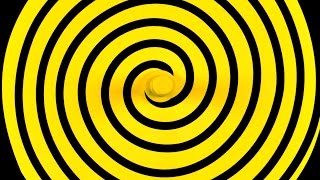(单词翻译:单击)
Check this out: Here's a grid, nothing special, just a basic grid, very grid-y.
看看:一个网格,无特别之处,只是个网格,很网格的。
But look closer, into this white spot at the center where the two central vertical and horizontal lines intersect.
但仔细看看中心的这个白点,两条中心横竖垂直的线交叉在一起。
Look very closely. Notice anything funny about this spot?
看仔细点。注意到这点有什么奇怪的吗?
Yeah, nothing. But keep looking. Get weird and stare at it.
对,没有。可是再继续盯着看。
Now, keeping your gaze fixed on this white spot, check what's happening in your peripheral vision.
现在,盯着这个白点,用余光看一下在发生什么。
The other spots, are they still white?
其它的点还是白色的吗?
Or do they show weird flashes of grey?
还是它们显出怪异的灰色闪光?
Now look at this pan for baking muffins.
现在看这个松饼烤盘。
Oh, sorry, one of the cups is inverted. It pops up instead of dipping down.
哦,对不起,一个杯子倒过来,它凸了起来而不是凹下去。
Wait, no spin the pan. The other five are domed now?
等一下,现在转一下烤盘。现在其它五个杯凸起来了吗?
Whichever it is, this pan's defective.
不管是哪一个,这个烤盘是有缺陷的。
Here's a photo of Abraham Lincoln, and here's one upside down. Nothing weird going on here.
这是一张林肯的照片,还有一张是倒放的。没什么怪异的地方。
Wait, turn that upside down one right side up. What have they done to Abe?
等一下,把倒放的照片放正。亚伯怎么了?
Those are just three optical illusions, images that seem to trick us. How do they work?
那只是三种视觉假象,似乎欺骗我们的图像。它们是如何产生的?
Are magical things happening in the images themselves?
魔术般的事情发生在图像本身吗?
While we could certainly be sneaking flashes of grey into the peripheral white spots of our animated grid,
虽然我们当然可以把灰色闪光放入动画网格的外围白点,
first off, we promise we aren't.
首先,我们发誓我们不会那样做。
You'll see the same effect with a grid printed on a plain old piece of paper.
网格如果印在一张普通的纸上,你也会看到同样的效果。
In reality, this grid really is just a grid. But not to your brain's visual system.
其实,这个网格就只是个网格。但对你的大脑的视觉系统它不是。
Here's how it interprets the light information you call this grid.
大脑是这么理解从所谓的网格来的光和信息的。
The white intersections are surrounded by relatively more white on all four sides than any white point along a line segment.
白色交点四周有更多的白色包围着,比沿着任何一条线段的白点还多。
Your retinal ganglion cells notice that there is more white around the intersections
你的视网膜神经节细胞注意到交点周围有更多的白色,
because they are organized to increase contrast with lateral inhibition.
因为侧抑制使他们增加对比。
Better contrast means it's easier to see the edge of something.
对比鲜明意味着较易看到东西的边缘。
And things are what your eyes and brain have evolved to see.
这些东西就是你的眼睛和大脑进化的结果。
Your retinal ganglion cells don't respond as much at the crossings
你的视网膜神经节细胞在交叉点没有过多的反应,
because there is more lateral inhibition for more white spots nearby compared to the lines, which are surrounded by black.
因为对附近更多的白点有更多的侧抑制,这是和黑色包围的线条相比。
This isn't just a defect in your eyes;
这不仅仅是你眼睛的缺陷;
if you can see, then optical illusions can trick you with your glasses on or with this paper or computer screen right up in your face.
如果你能看到,即使你戴着眼镜,或用这张纸,或就在你面前的电脑屏幕,错觉会欺骗你。

What optical illusions show us is the way your photo receptors and brain
错觉向我们显示的是你的光受体和大脑
assemble visual information into the three-dimensional world you see around you,
把可视信息组装成你周围看到的三维世界的方式,
where edges should get extra attention because things with edges can help you or kill you.
三唯世界里应额外注意边,因为带边的东西既能帮你也会杀了你。
Look at that muffin pan again. You know what causes confusion here?
再看那个松饼盘。你知道是什么引起了混乱吗?
Your brain's visual cortex operates on assumptions about the lighting of this image.
你大脑的视觉皮层对这个图像的照明在进行假设。
It expects light to come from a single source, shining down from above.
假设光是从上方照下来的单一光源。
And so these shading patterns could only have been caused by light shining down on the sloping sides of a dome, or the bottom of a hole.
所以这些阴影模式只能是由照下来的光引起的,是照在圆顶斜面上的光,还是照在凹下去的底部的光。
If we carefully recreate these clues by drawing shading patterns,
如果我们绘制阴影图案来仔细重建这些线索,
even on a flat piece of paper, our brain reflexively creates the 3D concave or convex shape.
甚至在一张平纸上,我们的大脑也会本能地创建三维凹或凸的形状。
Now for that creepy Lincoln upside down face.
现在就说林肯那张异样的上下颠倒的脸。
Faces trigger activity in areas of the brain that have specifically evolved to help us recognize faces.
脸触发大脑区域的活动,专门进化帮我们识别人脸。
Like the fusiform face area and others in the occipital and temporal lobes.
例如梭状回面孔区或枕叶和颞叶的某些区域。
It makes sense, too, we're very social animals with highly complex ways of interacting with each other.
这也是有道理的,我们是非常社会化的动物,具有相互作用的极其复杂的方式。
When we see faces, we have to recognize they are faces and figure out what they're expressing very quickly.
我们看脸的时候不得不认出它们是脸,并非常迅速地想出它们在表达什么。
And what we focus on most are the eyes and mouth.
我们注意最多的是眼睛和嘴。
That's how we figure out if someone is mad at us or wants to be our friend.
我们就是这样判断出别人是对我们生气了,还是想和我们做朋友。
In the upside down Lincoln face, the eyes and mouth were actually right side up, so you didn't notice anything was off.
林肯那张上下颠倒的脸,实际上眼睛和嘴是右面在上,所以,你没注意到少了什么。
But when we flipped the whole image over,
但当我们把整个图像翻转过来,
the most important parts of the face, the eyes and mouth,
脸最重要的部分,眼睛和嘴,
were now upside down, and you realized something fishy was up.
现在上下颠倒了,所以你意识到有点不对劲。
You realized your brain had taken a short cut and missed something.
你意识到大脑走了捷径而错过了什么。
But your brain wasn't really being lazy, it's just very busy.
但你的大脑不是真犯懒,它只是很忙而已。
So it spends cognitive energy as efficiently as possible,
所以大脑尽可能高效地使用认知力,
using assumptions about visual information to create a tailored, edited vision of the world.
利用有关视觉信息的假设,来创造一个量身定做的、编辑了的世界景象。
Imagine your brain calling out these edits on the fly:
想象一下你的大脑匆忙调出这些编辑:
'Okay, those squares could be objects.
“好了,那些方块儿可能是物体。
Let's enhance that black-white contrast on the sides with lateral inhibition.
用侧抑制在两侧让我们增强黑白对比。
Darken those corners! Dark grey fading into light grey?
使那些角落变暗!深灰色褪成了浅灰色吗?
Assume overhead sunlight falling on a sloping curve. Next!
假设上面的阳光落在一条倾斜的曲线上。接着!
Those eyes look like most eyes I've seen before, nothing weird going on here.'
那些眼睛看上去像我以前看见的大部分眼睛,没有什么奇怪的。
See? Our visual tricks have revealed your brain's job as a busy director of 3D animation in a studio inside your skull,
看见了?我们视觉上的幻觉揭示了我们大脑的工作,它仿佛是你的脑壳工作室里一个忙碌的三维动画导演,
allocating cognitive energy and constructing a world on the fly with tried and mostly -- but not always -- true tricks of its own.
经常但并不总是用自身具有的一些手法,分配认知能量并快速构建一个世界。


